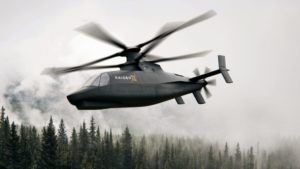Sikorsky [LMT] expects delivery of the Army’s new General Electric Aviation [GE]-built helicopter engine in October, according to the company’s president, adding that puts its Future Attack Reconnaissance Aircraft (FARA) prototype on track for first flight in summer of 2024.
“I can only tell you what the Army and GE are telling us, and that’s the latest that they have,” Sikorsky President Paul Lemmo told reporters during a briefing on Tuesday.

The updated timeline from Lemmo follows the Army confirming delivery of the GE T901 engines, developed under Improved Turbine Engine Program (ITEP), had been delayed again to early 2024 due to “manufacturing challenges” (Defense Daily, March 15).
The Army has selected Sikorsky’s Raider X and Bell’s [TXT] 360 Invictus designs for the FARA competitive prototyping phase as it looks to field a new scout attack helicopter.
Lemmo’s briefing on Tuesday followed Sikorsky’s announcement last week it would not seek further legal action regarding the Army’s Future Long Range Assault Aircraft (FLRAA) program, which followed the Government Accountability Office’s (GAO) denial of its protest on the award to Bell (Defense Daily, April 18).
“While we’re obviously disappointed with the outcome of the competition, we’re carefully examining the feedback that we received on the proposal and we’re going to apply those lessons to future capture efforts with the Army and all of our customers,” Lemmo told reporters.
Bell’s V-280 Valor tiltrotor aircraft design was named the winner of the FLRAA competition on Dec. 5, beating out a Sikorsky and Boeing [BA] team’s Defiant X coaxial rigid rotor helicopter offering for the program to find an eventual UH-60 Black Hawk helicopter replacement (Defense Daily, Dec. 5).
The Army’s initial FLRAA deal to Bell is worth up to $1.3 billion but could total $7 billion if all options are picked up.
Lemmo said Sikorsky will take lessons learned from the FLRAA loss and apply them to future opportunities, to include the FARA program, and said the company received positive feedback on the maturity and capability of the X2 technology underlying its next-generation helicopter offerings.
“That gives us the confidence that we’ve always had. It reinforces that confidence in the technology of X2 and its applicability to Army missions, including obviously the FARA program,” Lemmo said. “The feedback that we received from the Army let us know that the agility, stability and scalability of our X2 technology can be extremely useful in contested areas, particularly the survivability of it. Again, we remain confident and excited about the technology.”
A redacted report that followed the GAO’s April 6 decision denying the protest noted, while the Sikorsky and Boeing team submitted a proposal that was $3.6 billion lower than eventual winner Bell’s estimated cost, the Army deemed the team’s bid “unacceptable” in the “architecture” subfactor for engineering and design (Defense Daily, April 14).
“I would say we are obviously learning from that and moving on. And we’ll take all the lessons learned to all of our future opportunities that we bid on,” Lemmo said. “And no one likes to lose a contract opportunity, but if there is good news, I think, the feedback that we received on X2 was very promising, very positive.”
On its X2 technology approach, which has included prototypes with counter-rotating rigid rotors and a propulsor system in place of a tail rotor, Lemmo said the “solution provides the Army with a connected, integrated weapon system that combines speed, range and maneuverability, as well as survivability and operational flexibility to execute in an emerging expanded threat environment.”
Lemmo noted Sikorsky’s Raider X prototype for FARA is now 96 percent complete at the company’s West Palm Beach, Florida facility, and is conducting items such as risk reduction with gearboxes as it waits for the ITEP engine.
“Unlike FLRAA, [Raider X for FARA] is going to have a very robust mission system with capabilities to be offensive but also, most importantly, to be an ISR asset on the battlefield. It’s really going to be a network sensor or a quarterback, if you will, for managing the effects and communications across platforms in the lower tier of the air domain,” Lemmo said.
Lemmo said the modular open systems approach to Raider X will allow for “plug-and-play options for computing, sensors, survivability, and weapons,” and said the platform will meet operational flexibility requirements with its speed ability, “a large multifunctional weapons bay and unprecedented acceleration and deceleration capability.”
Sikorsky has also been flying its S-97 Raider technology demonstrator helicopter since 2015, which company officials have said is feeding critical data collection to help ensure Raider X will offer a “lower risk” option for FARA (Defense Daily, July 6 2022).
“We’re the only company right now with a representative FARA flying technology demonstrator,” Lemmo told reporters. “That flight program reduces risk on FARA by informing design decisions and correlating to our virtual prototype, enabling us to continue to advance the transformational capabilities that X2 provides.”
Doug Bush, the Army’s top acquisition official, told lawmakers last week the ITEP engine delay has pushed back the FARA schedule by around eight months, with a Milestone B decision now planned for the first quarter of fiscal year 2026 (Defense Daily, April 20).